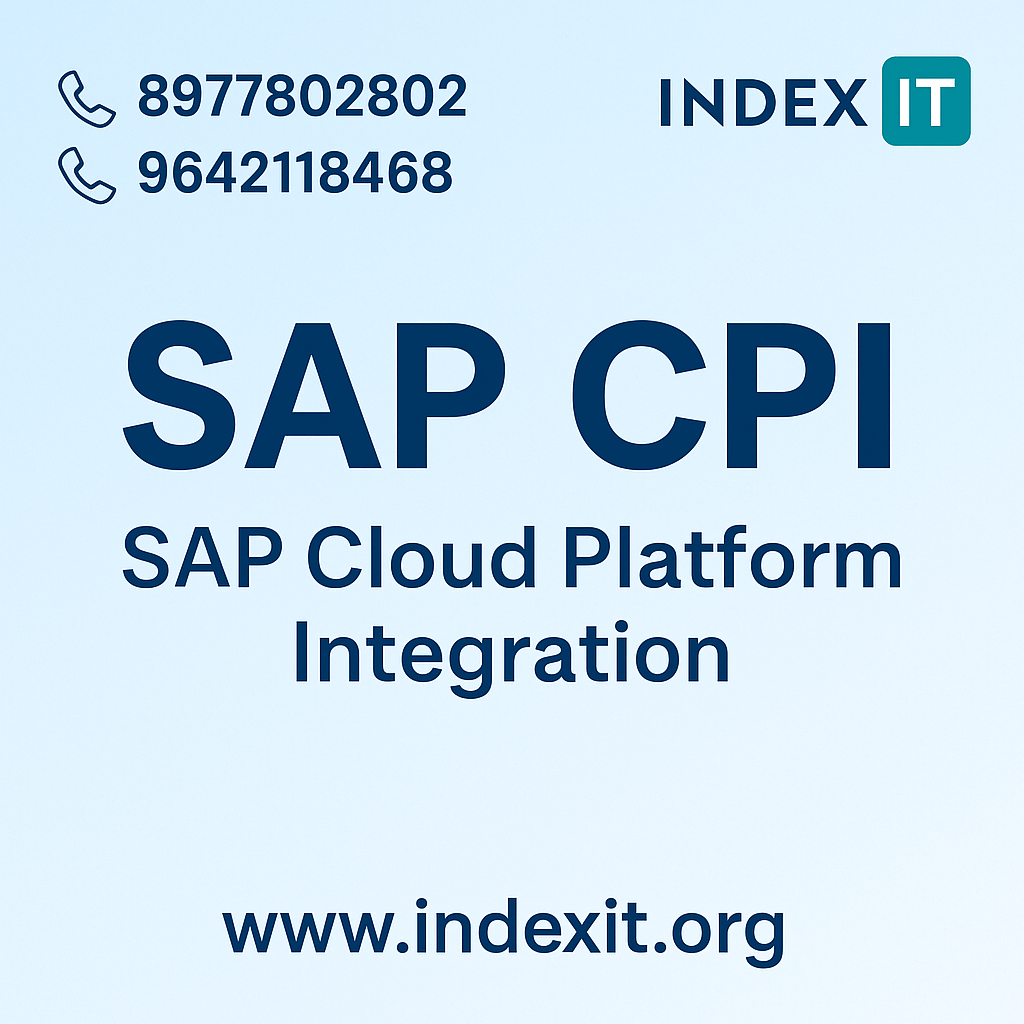Our Location
Index IT SAP St, Gayatri Nagar, Srinivasa Nagar,
Ameerpet, Hyderabad, Telangana - 500016
Phone: +91-8977802802
Email: indexit4sap@gmail.com
Index IT SAP St, Gayatri Nagar, Srinivasa Nagar,
Ameerpet, Hyderabad, Telangana - 500016
Phone: +91-8977802802
Email: indexit4sap@gmail.com
As more companies move to SAP S/4HANA Cloud and SuccessFactors, the need for real-time data integration has skyrocketed. SAP Cloud Platform Integration (CPI)—part of the SAP Business Technology Platform (BTP)—makes this possible by securely connecting cloud and on-premise applications.
At Index IT Training Institute, Hyderabad (Ameerpet), we help students master CPI integration through real-time projects, 24/7 server access, and daily recorded sessions.
Also learn companion skills: SAP BTP ABAP • Explore official resources on the SAP API Business Hub.

Legacy middleware like SAP PI/PO is being phased out, making SAP Cloud Platform Integration (CPI) the go-to platform for modern enterprises that want seamless and secure cloud connectivity.
Key Advantages
💡 Also check out our SAP BTP ABAP Training in Hyderabad to learn how to extend CPI flows using ABAP on Cloud.
A typical integration scenario between SAP SuccessFactors and SAP S/4HANA involves three key layers. Each layer performs a unique function in transferring and transforming data through SAP Cloud Platform Integration (CPI).
To practice building these integrations, explore our SAP CPI Training in Hyderabad program, where students learn real-world integration scenarios under expert guidance.
The following steps outline how to integrate SAP Cloud Platform Integration (CPI) with SAP S/4HANA and SuccessFactors for secure and seamless data exchange.
Begin by setting up the SAP Cloud Connector to establish a secure tunnel between CPI and the on-premise S/4HANA system. Define destination URLs and credentials for both SuccessFactors and S/4HANA inside the BTP Cockpit.
Access the SAP API Business Hub to import pre-packaged integration flows such as Employee Master Replication or Cost Center Integration. These templates follow SAP best practices and accelerate deployment.
Customize sender and receiver adapters, define mapping logic, and update authentication parameters. The CPI Web UI allows visual configuration for easier maintenance and testing.
Deploy your iFlow to the CPI tenant. Use Message Monitoring to validate payloads, track responses, and troubleshoot any mapping or authentication errors.
Schedule regular monitoring in the Operations View of CPI. Set alerts for failures, enable retries for critical messages, and review performance dashboards to ensure stability of production integrations.
For hands-on practice of these real-world CPI scenarios, enroll in our SAP CPI Training in Hyderabad at Index IT and gain live integration experience with 24 / 7 server access.
Even well-designed integrations can face hurdles. Use the patterns below to keep your SAP Cloud Platform Integration (CPI) interfaces with S/4HANA and SuccessFactors stable, secure, and performant.
Need hands-on mapping practice? Join our SAP CPI Training in Hyderabad (Index IT) .
For deeper guidance, see the official SAP Cloud Integration documentation .
Want a production-ready checklist and mock interviews focused on Hyderabad placements? Explore our SAP CPI course at Index IT and strengthen your integrations alongside SAP BTP ABAP .
In this example, new employee data created in SAP SuccessFactors is replicated to SAP S/4HANA using SAP Cloud Platform Integration (CPI). The flow uses OData at the source, transformation/mapping in CPI, and an IDoc or OData service on the S/4HANA side.
OData API → Employee Profile / Org Data
iFlow • Groovy • XML/JSON Mapping • Validation
IDoc / OData Service → HR Master Update
Tip: Start from SAP-certified content on the SAP API Business Hub and adapt the iFlow to your org’s data model. For hands-on practice, join SAP CPI Training in Hyderabad (Index IT).
SAP Cloud Platform Integration (CPI) connects SAP and non-SAP apps securely across cloud and on-premise. Typical use cases include SuccessFactors → S/4HANA employee replication, Salesforce–SAP order sync, and Ariba procurement flows. You can explore certified templates on the SAP API Business Hub, then tailor them in iFlows.
Yes—CPI is SAP’s cloud-first integration platform and the strategic successor to PI/PO for modern APIs and hybrid landscapes. For a practical comparison, read our blog SAP CPI vs PI/PO – Which One Should You Learn in 2025?
CPI includes HTTPS, SOAP, OData, IDoc, SFTP, and more—plus tooling for Groovy scripting, XML/JSON mappings, and monitoring in the Integration Suite cockpit. See the official capabilities on SAP Developers (Cloud Integration).
Absolutely. Hyderabad (Ameerpet) has strong demand for integration consultants across S/4HANA, SuccessFactors, and Ariba. Build job-ready skills with hands-on iFlows, live servers, and mock interviews in our SAP CPI Training in Hyderabad (Index IT).
You don’t need advanced ABAP for CPI, but understanding data models and APIs helps. To extend or complement CPI scenarios, many learners add SAP BTP ABAP for server-side logic on SAP BTP.
Start with SAP-certified iFlows from the SAP API Business Hub, then modify mappings and adapters. Our Index IT CPI course provides 24/7 lab access and real-time projects so you can build confidence fast.
Join Index IT Training Institute – Ameerpet, Hyderabad for hands-on iFlows, real-time projects, 24/7 server access, daily recordings, and full placement assistance.
Batch options: weekday / weekend • Online & classroom
Want the complete CPI syllabus or a free demo? Ping us on WhatsApp or click Enroll Now.
